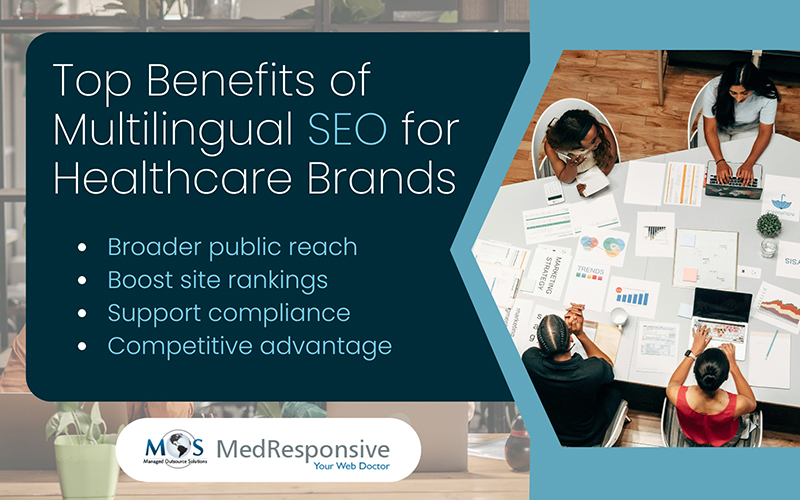Healthcare businesses are increasingly relying on online advertising in the pursuit of a new patient base. Content marketing, social media posts, and paid ads are all effective methods that provide considerable results in the competitive healthcare market. However, these digital marketing strategies impact only specific targets of the audience, the English-speaking demographic. While English is the most widely used language, it is estimated that there are over 66 million in the U.S that do not speak English at home. Multilingual SEO for clinics is essential in today’s diverse healthcare market. Multilingual SEO strategy is vital in bridging the gap between diverse populations and medical access. With the help of experienced healthcare SEO services, medical clinics can succeed in multilingual markets without consuming additional in-house time or resources.
What Is Multilingual SEO in Healthcare and Why Is It Important for Medical Websites?
Multilingual SEO in healthcare is the practice of optimizing a medical website for a diverse linguistic audience. This strategy focuses on aligning content with the target audience’s preferred language, search behavior, and cultural context. It may involve translating and localizing medical content, conducting language-specific keyword research, and implementing hreflang tags in SEO to signal language and regional targeting to search engines.
By adapting websites for multilingual searches, healthcare businesses can drive organic traffic from diverse populations and regions. The goal is to ensure patients can easily find, use, and trust the healthcare provider’s website in their native language, improving accessibility and engagement rates across regions.
Multilingual medical SEO provides unique benefits such as the following to healthcare practitioners seeking to expand their services to a more diverse audience base:
- Broader public reach: Brands that aim to expand market visibility can implement multilingual marketing in healthcare to connect with local audiences. For instance, a clinic operating in New York can attract a diverse population by creating localized landing, services, and FAQ pages in popular languages such as Spanish. Multi-location healthcare businesses can also strengthen local presence by optimizing for each branch tailored to the languages spoken in that region.
- Boost site rankings: Medical websites that optimize for multiple languages help to signal relevance and authority to search engines across regions. As search engines identify all translated versions as embedded in one site, it consolidates traffic instead of dividing it. Moreover, as patients can search and find information in their preferred language, it will increase engagement rates, leading to longer visits, lower bounce rates, and ultimately, better rankings.
- Support compliance: Beyond marketing benefits, multilingual SEO also supports healthcare organizations in meeting ethical and legal considerations. In certain regions, healthcare providers are required to make vital documents such as consent forms and intake forms accessible to LEP individuals or in the region’s local language. Language-based optimization supports HIPAA-compliant SEO efforts by optimizing digital access to these resources, thus reducing the risk of non-compliance and potential penalties.
- Competitive advantage: Healthcare brands that prioritize audience preferences, inclusivity, and data-driven insights by investing in language-targeted SEO gain significant advantage in today’s diverse market. As certain regions have their own search engines that are not Google or Bing, optimizing for local search platforms ensures better visibility and access to local patient populations. By adapting SEO strategies to fit regional search behaviors and linguistic nuances, healthcare organizations can effectively reach and engage multilingual audiences, setting themselves apart from competitors who focus solely on global platforms like Google.
How to Implement Multilingual SEO for Medical Websites
Healthcare organizations seeking to implement an effective and successful SEO strategy for their multilingual websites can follow the following unique steps:
Market Research
Before diving into cross-language SEO strategy, healthcare providers must assess if it’s an appropriate approach for their target audience and objectives. This involves conducting thorough market research to identify:
- Audience demographic
- Market size and opportunities
- Key competitors
- Local search behavior and preferred platforms
Brands can learn about these important details using tools such as Google Analytics (GA) and Google Search Console (GSC). These tools uncover insights such as user behavior metrics, search volumes, keyword performance, and regional traffic distributions. Use this data to consider high-converting regions, countries, and patient language preferences to ensure your SEO efforts are tailored to specific audience needs and requirements. Healthcare brands that prioritize these key factors can yield the best return on investment (ROI).
Conduct Keyword Research
Keyword research in cross-language optimization in healthcare is distinct as it goes beyond simple translation of English keywords. It requires understanding how patients search for medical information and services in their native language. This involves,
- Finding out high-traffic and relevant keywords specific to each language and region
- Analyzing search intent and local terminology to select keywords that accurately reflect how patients phrase their medical needs
- Identifying high-performing LSI terms and long tail keywords that are specific to your specialty, procedures, and diagnosis
For example, regional variations in terms, expressions, and dialects of Spanish speakers in the U.S. should be considered as it differs compared to users from Mexico or Spain. Tools such as Google Keyword Planner, Ahrefs, or SEMrush can support this location-specific and language-specific keyword research. Incorporate these keywords naturally into website content, meta descriptions, and headings to enhance the site’s visibility and relevance in local search results.
Create Website URL Structure
In order to effectively enhance user experience and positively impact search engine rankings, create a clear and logical URL system for your multilingual clinic website. A well-structured URL is essential to help search engines index your content, improve usability for patients, and prevent duplicate content issues. Here are the three recommended structures for URLs:
- Country Code Top-Level Domains (ccTLDs): For healthcare organizations with a global presence, using country-specific top-level domains (such as example.de) provides robust local SEO benefits. This type supports maximum geo-targeting signals and region-level customization but requires higher resources and maintenance expenses.
- Sub domains: For clinics operating across multiple regions or countries, this option allows content to be separated by language using prefixes, such as fr.example.com for French. Sub domains provide moderate geo-targeting capabilities, support flexibility for content management and are easier to manage compared to ccTLDs. This structure can be beneficial for organizations that want to maintain unified brand presence while segmenting their content by language.
- Subdirectories: Subdirectories organize language-specific content within folders of the main domain, for example, example.com/es/ for Spanish pages. This approach simplifies site maintenance and consolidates domain authority, making it a cost-effective solution for medical SEO.
Localize and Translate Content
The cornerstone of Multilanguage SEO involves localization and translation of your original medical content. In this process, website owners adapt and customize content to match the cultural background, social characteristics, and medical terminology preferences of the target audience. Depending on an auto-translate tool for this may backfire as they lack the expertise of professional translation experts. Localization is about adapting not only the website’s language but also cultural nuances, accessibility, and functionality according to the target users. This involves,
- Ensuring the terminology matches local medical standards and patient expectations
- Updating visual examples, and regional elements such as time, currencies, and measurement units to reflect the local cultural preferences and norms
- Regularly updating localized content to stay relevant with evolving medical guidelines
For instance, healthcare jargon familiar to English-speaking Americans may need adjustments to resonate with English speakers from other countries, such as Britain or Australia. Review your content with professional medical content experts or native speakers for this task as they understand not just the language but also the medical context behind it.
Implement hreflang Tags
Hreflang tags are an HTML attribute that inform search engines about the localized variations in language and region of the webpage. This helps avoid duplicate content issues and ensures visitors see the intended version of your site. Without hreflang, your content risks being shown to the wrong audience, such as English content being displayed to French speakers. Hreflang tags also make sure search engines correctly index all versions of your site.
- Add hreflang tags to every translated page, not just the homepage.
- Include a self-referencing tag so search engines know which page version they are indexing.
- Regularly check Google Search Console for hreflang errors and fix them promptly.
Correctly implementing hreflang tags can improve search visibility for all your target audiences and reduce the chance of your pages competing against each other in search results.
Optimize Technical SEO Elements
Technical SEO is the basis for a successful multilingual site, optimizing aspects such as server performance, URL structures, and canonical tags across different site versions. Healthcare providers must also ensure fast loading speeds, mobile responsiveness, and secure connections to protect sensitive patient information. Proper technical setup helps search engines crawl and index all language versions correctly, ultimately contributing to rankings of your site.
- Optimize images and server response times to speed up page loading.
- Make sure every language version works well on mobile devices.
- Use SSL certificates to secure data and protect sensitive user information from breaches.
Search engines evaluate your site both in terms of content and its technical functionality, making technical SEO a top priority for websites. A secure, fast, and mobile-friendly site improves user experience and search rankings across all languages.
Monitor and Analyze Performance
Tracking how your multilingual site performs is essential for improving and sustaining your SEO results. Tools like Google Analytics and Search Console allow healthcare marketers to see which languages and regions drive the highest ROI. With regular analysis, you can uncover content gaps, monitor user behavior and adjust optimization strategies in a timely manner.
- Set up reports that separate traffic and user behavior by language and region.
- Analyze engagement and conversions to find areas needing improvement.
- Use these insights to update keywords and content on a regular schedule.
SEO is not a set-it-and-forget-it task, especially for medical sites serving multiple languages. Constant monitoring helps you adapt to changing user needs and keeps your clinic visible to all patient groups.
Hire an Expert
Investing in a multilingual SEO strategy enables healthcare brands to meet the expectations of a varied audience and thrive in an increasingly diverse marketplace. By partnering with a reputable healthcare SEO agency, clinics can enhance accessibility, build trust, and expand audience reach.
Improve your clinic’s online visibility for diverse communities by partnering with our SEO specialists!





